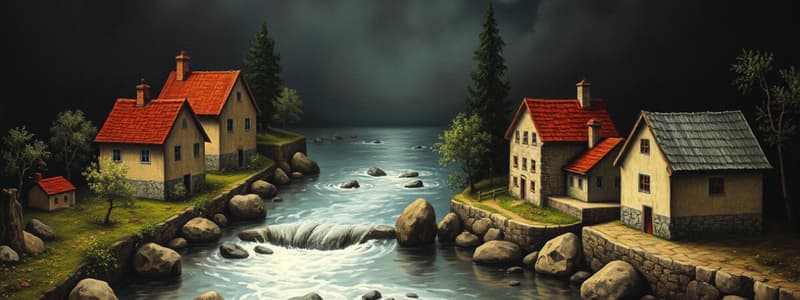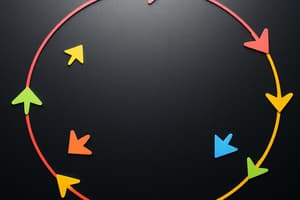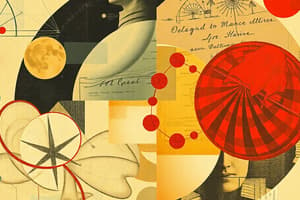Podcast
Questions and Answers
What are the two main economic actors in the circular flow model?
What are the two main economic actors in the circular flow model?
Households and businesses.
How does money flow in the circular flow model, and what is its direction?
How does money flow in the circular flow model, and what is its direction?
Money flows clockwise in the economy.
What roles do households play in the economy, particularly regarding resources?
What roles do households play in the economy, particularly regarding resources?
Households own economic resources and sell them to businesses in exchange for income.
What distinguishes the market for resources from the market for goods and services?
What distinguishes the market for resources from the market for goods and services?
Identify the four key economic resources mentioned in the circular flow model.
Identify the four key economic resources mentioned in the circular flow model.
What is the significance of entrepreneurial ability in the circular flow model?
What is the significance of entrepreneurial ability in the circular flow model?
Explain how income generation occurs within households.
Explain how income generation occurs within households.
What example illustrates the flow of transactions within the circular flow model?
What example illustrates the flow of transactions within the circular flow model?
Describe the circular flow of resources and how it operates between households and businesses.
Describe the circular flow of resources and how it operates between households and businesses.
How do businesses utilize the revenue generated from selling goods and services?
How do businesses utilize the revenue generated from selling goods and services?
How do households contribute to the economy beyond providing economic resources?
How do households contribute to the economy beyond providing economic resources?
What is the role of businesses in the circular flow model?
What is the role of businesses in the circular flow model?
Explain the significance of the interaction between the market for resources and the market for goods and services.
Explain the significance of the interaction between the market for resources and the market for goods and services.
Discuss how the flow of money and goods/services in the circular flow model affects economic stability.
Discuss how the flow of money and goods/services in the circular flow model affects economic stability.
What types of income do households earn, and how do these contribute to the economy?
What types of income do households earn, and how do these contribute to the economy?
How does entrepreneurial ability impact the circular flow model?
How does entrepreneurial ability impact the circular flow model?
Describe the importance of reinvestment of profits by businesses within the circular flow model.
Describe the importance of reinvestment of profits by businesses within the circular flow model.
What role does labor play in the circular flow model and its impact on economic growth?
What role does labor play in the circular flow model and its impact on economic growth?
In what way does the circular flow model illustrate the interdependence of households and businesses?
In what way does the circular flow model illustrate the interdependence of households and businesses?
How does the flow of economic resources from households to businesses support overall economic activity?
How does the flow of economic resources from households to businesses support overall economic activity?
Flashcards are hidden until you start studying
Study Notes
Circular Flow Model Overview
- The circular flow model illustrates the interactions between households and businesses within an economy.
- It depicts the flow of economic resources, goods and services, and money.
Economic Actors
- Households: Comprising one or more persons living together, they own all economic resources, including land, labor, capital, and entrepreneurial ability.
- Businesses: Privately owned organizations producing and selling goods and services, ranging from large corporations to small local establishments.
Key Economic Resources
- Land: Natural resources, like oil, water, and agricultural land.
- Labor: The workforce providing services for wages.
- Capital: Goods used for production, such as machinery and tools.
- Entrepreneurial Ability: The capacity to combine resources innovatively to produce goods and services, assuming financial risks.
Flow of Money and Resources
- Money circulates clockwise in the economy while goods and services flow counter-clockwise.
- Households sell economic resources to businesses and use income to purchase goods and services.
Market Interaction
- Market for Resources: Households sell resources (labor, land, capital) to businesses in exchange for income.
- Market for Goods and Services: Businesses sell the goods and services produced to households, resulting in revenue.
Transactions in the Circular Flow
- Example: A consumer buys food at a diner, providing revenue that the diner uses to pay employees, source ingredients, and cover operational costs.
- The diner’s owner reinvests profits in the business, maintaining the circular flow of income.
Income Generation
- Households earn income through various means: wages (labor), rent (land), interest (capital), and profits (entrepreneurship).
- Income facilitates the purchasing of goods and services, driving further economic activity.
Mutual Dependency
- Households and businesses rely on each other: households provide resources, while businesses provide goods and services.
- Both are active players in the economy, functioning as buyers and sellers across different markets.
Economic Cycles
- The circular flow model simplifies complex economic interactions and highlights the continuous cycle of spending and earning.
- It serves as a foundational tool for understanding economic relationships and resource distribution within an economy.
Circular Flow Model Overview
- Illustrates interactions between households and businesses in an economy.
- Depicts the circulation of economic resources, goods and services, and money.
Economic Actors
- Households: Groups of individuals owning economic resources such as land, labor, capital, and entrepreneurial capacity.
- Businesses: Organizations, ranging from large corporations to small local shops, engaged in producing and selling goods and services.
Key Economic Resources
- Land: Includes natural resources like oil, water, and agricultural areas.
- Labor: Workforce providing services for wages.
- Capital: Equipment and materials used in the production process, including machinery and tools.
- Entrepreneurial Ability: Skill to innovate and combine resources for producing goods/services while assuming financial risks.
Flow of Money and Resources
- Money flows clockwise through the economy; goods and services flow counter-clockwise.
- Households sell economic resources to businesses and use the income earned to purchase goods and services.
Market Interaction
- Market for Resources: Households exchange labor, land, and capital for income from businesses.
- Market for Goods and Services: Businesses sell produced goods and services to households, generating revenue.
Transactions in the Circular Flow
- Example: A consumer purchasing food at a diner generates revenue that allows the diner to pay employees and acquire ingredients.
- Diner owners reinvest profits back into the business, sustaining the flow of income.
Income Generation
- Households generate income through wages (labor), rent (land), interest (capital), and profits (entrepreneurship).
- Income enables households to buy goods and services, stimulating economic activity.
Mutual Dependency
- Households provide resources while businesses offer goods and services, establishing a mutual reliance.
- Both entities are integral to the economy, serving as buyers and sellers in various markets.
Economic Cycles
- The model simplifies and highlights the continuous cycle of spending and earning.
- Acts as a foundational framework for understanding economic relationships and the distribution of resources within an economy.
Circular Flow Model Overview
- Illustrates interactions between households and businesses in an economy.
- Depicts the circulation of economic resources, goods and services, and money.
Economic Actors
- Households: Groups of individuals owning economic resources such as land, labor, capital, and entrepreneurial capacity.
- Businesses: Organizations, ranging from large corporations to small local shops, engaged in producing and selling goods and services.
Key Economic Resources
- Land: Includes natural resources like oil, water, and agricultural areas.
- Labor: Workforce providing services for wages.
- Capital: Equipment and materials used in the production process, including machinery and tools.
- Entrepreneurial Ability: Skill to innovate and combine resources for producing goods/services while assuming financial risks.
Flow of Money and Resources
- Money flows clockwise through the economy; goods and services flow counter-clockwise.
- Households sell economic resources to businesses and use the income earned to purchase goods and services.
Market Interaction
- Market for Resources: Households exchange labor, land, and capital for income from businesses.
- Market for Goods and Services: Businesses sell produced goods and services to households, generating revenue.
Transactions in the Circular Flow
- Example: A consumer purchasing food at a diner generates revenue that allows the diner to pay employees and acquire ingredients.
- Diner owners reinvest profits back into the business, sustaining the flow of income.
Income Generation
- Households generate income through wages (labor), rent (land), interest (capital), and profits (entrepreneurship).
- Income enables households to buy goods and services, stimulating economic activity.
Mutual Dependency
- Households provide resources while businesses offer goods and services, establishing a mutual reliance.
- Both entities are integral to the economy, serving as buyers and sellers in various markets.
Economic Cycles
- The model simplifies and highlights the continuous cycle of spending and earning.
- Acts as a foundational framework for understanding economic relationships and the distribution of resources within an economy.
Studying That Suits You
Use AI to generate personalized quizzes and flashcards to suit your learning preferences.




